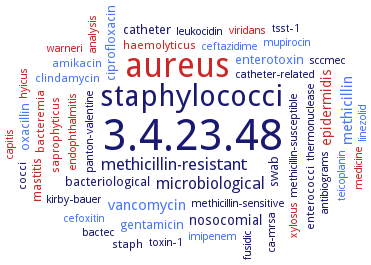3.4.23.48: plasminogen activator Pla
This is an abbreviated version!
For detailed information about plasminogen activator Pla, go to the full flat file.

Word Map on EC 3.4.23.48 
-
3.4.23.48
-
aureus
-
staphylococci
-
methicillin-resistant
-
microbiological
-
methicillin
-
vancomycin
-
nosocomial
-
epidermidis
-
gentamicin
-
mastitis
-
catheter
-
enterotoxin
-
oxacillin
-
swab
-
ciprofloxacin
-
bacteriological
-
cocci
-
amikacin
-
clindamycin
-
enterococci
-
saprophyticus
-
haemolyticus
-
staph
-
bacteremia
-
methicillin-susceptible
-
catheter-related
-
viridans
-
mupirocin
-
tsst-1
-
antibiograms
-
linezolid
-
xylosus
-
kirby-bauer
-
panton-valentine
-
hyicus
-
ceftazidime
-
thermonuclease
-
cefoxitin
-
analysis
-
medicine
-
leukocidin
-
teicoplanin
-
methicillin-sensitive
-
endophthalmitis
-
warneri
-
fusidic
-
sccmec
-
toxin-1
-
imipenem
-
ca-mrsa
-
bactec
-
capitis
- 3.4.23.48
- aureus
-
staphylococci
-
methicillin-resistant
-
microbiological
- methicillin
- vancomycin
-
nosocomial
- epidermidis
- gentamicin
- mastitis
-
catheter
- enterotoxin
- oxacillin
-
swab
- ciprofloxacin
-
bacteriological
-
cocci
- amikacin
- clindamycin
-
enterococci
- saprophyticus
- haemolyticus
-
staph
- bacteremia
-
methicillin-susceptible
-
catheter-related
- viridans
- mupirocin
-
tsst-1
-
antibiograms
- linezolid
- xylosus
-
kirby-bauer
-
panton-valentine
- hyicus
- ceftazidime
- thermonuclease
- cefoxitin
- analysis
- medicine
-
leukocidin
- teicoplanin
-
methicillin-sensitive
- endophthalmitis
- warneri
-
fusidic
-
sccmec
-
toxin-1
- imipenem
-
ca-mrsa
-
bactec
- capitis
Reaction
Converts human Glu-plasminogen to plasmin by cleaving the Arg560-/-Val peptide bond that is also hydrolysed by the mammalian u-plasminogen activator and t-plasminogen activator. Also cleaves arginyl bonds in other proteins =
Synonyms
beta-Pla, coagulase, fibrinolysin, outer membrane protease, Pla, Pla protease, plasminogen activator, plasminogen activator Pla, plasminogen activator protease Pla, YapE
ECTree
Advanced search results
Crystallization
Crystallization on EC 3.4.23.48 - plasminogen activator Pla
Please wait a moment until all data is loaded. This message will disappear when all data is loaded.
co-crystal structure of lipopolysaccharide-free Pla in complex with the activation loop peptide of human plasminogen, its natural substrate. The structure shows that in the absence of lipopolysaccharide, the peptide substrate binds deep within the active site groove and displaces the nucleophilic water molecule, leading to inactivation
comparison of the structure of Pla and the modeled structure of protease Epo of the plant pathogenic Erwinia pyrifoliae
molecular dynamics simulation of interaction with plasminogen. After a total of 8 ns, the predicted docked complex of plasminogen-palsminogen activator Pla shows the relaxation of the beta-barrel structure of Pla and the progressive approximation and stabilization between the cleavage site of plasmnogen into the extracellular loops of Pla, followed by the increase in the number of H bonds
-
wild-type, to 1.9 A, and inactive mutant D86A, to 2.5 A resolution, respectively. The structure shows a water molecule located between active site residues D84 and H208, and a number of other water molecules. The R211 side-chain in loop L4 is close to the nucleophilic water and possibly involved in the stabilization of the oxyanion intermediate. Subtle conformational changes of H208 result from the binding of lipopolysaccharide to the outside of the barrel, explaining the unusual dependence of omptins on lipopolysaccharide for activity


 results (
results ( results (
results ( top
top





